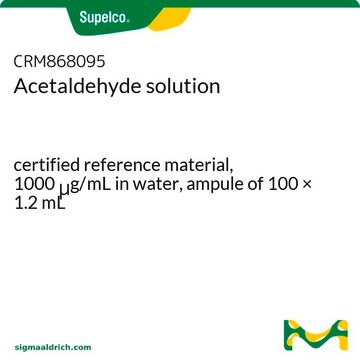506788
Acetaldehído
PESTANAL®, analytical standard
Sinónimos:
Etanal
About This Item
Productos recomendados
grado
analytical standard
Nivel de calidad
densidad de vapor
1.52 (vs air)
presión de vapor
14.63 psi ( 20 °C)
Línea del producto
PESTANAL®
CofA
current certificate can be downloaded
temp. de autoignición
365 °F
lim. expl.
60 %
envase
ampule of 1000 mg
técnicas
HPLC: suitable
gas chromatography (GC): suitable
índice de refracción
n20/D 1.332 (lit.)
bp
21 °C (lit.)
mp
−125 °C (lit.)
densidad
0.785 g/mL at 25 °C (lit.)
aplicaciones
agriculture
cleaning products
cosmetics
environmental
flavors and fragrances
food and beverages
personal care
Formato
neat
temp. de almacenamiento
2-8°C
cadena SMILES
CC=O
InChI
1S/C2H4O/c1-2-3/h2H,1H3
Clave InChI
IKHGUXGNUITLKF-UHFFFAOYSA-N
¿Está buscando productos similares? Visita Guía de comparación de productos
Categorías relacionadas
Descripción general
Aplicación
Información legal
Palabra de señalización
Danger
Frases de peligro
Consejos de prudencia
Clasificaciones de peligro
Carc. 1B - Eye Irrit. 2 - Flam. Liq. 1 - Muta. 2 - STOT SE 3
Órganos de actuación
Respiratory system
Código de clase de almacenamiento
3 - Flammable liquids
Clase de riesgo para el agua (WGK)
WGK 3
Punto de inflamabilidad (°F)
-38.0 °F - closed cup
Punto de inflamabilidad (°C)
-38.89 °C - closed cup
Equipo de protección personal
Eyeshields, Faceshields, Gloves
Listados normativos
Los listados normativos se proporcionan para los productos químicos principalmente. Para los productos no químicos sólo se puede proporcionar información limitada. Si no hay ninguna entrada, significa que ninguno de los componentes está en la lista. Es obligación del usuario garantizar el uso seguro y legal del producto.
EU REACH Annex XVII (Restriction List)
Elija entre una de las versiones más recientes:
¿Ya tiene este producto?
Encuentre la documentación para los productos que ha comprado recientemente en la Biblioteca de documentos.
Los clientes también vieron
Protocolos
-Tolualdehyde; Valeraldehyde; Isovaleraldehyde
Separation of Acetone; Acetic acid; Propionic acid; Ethyl butyrate; Ethanol; Isoamyl acetate; Isobutyric acid; 3-Methyl-2-butanol; Methyl acetate; 1-Propanol; Acetal, ≥98%, FG; 2-Methyl-1-pentanol; Butyl acetate; Ethyl propionate; 3-Pentanol; 2-Pentanol, 98%; Ethyl isobutyrate; Isobutyl acetate; Acetaldehyde; Furfural; Butyric acid; Methanol; Ethyl acetate
Global Trade Item Number
| Número de referencia del producto (SKU) | GTIN |
|---|---|
| 506788 | 4061837424090 |
Nuestro equipo de científicos tiene experiencia en todas las áreas de investigación: Ciencias de la vida, Ciencia de los materiales, Síntesis química, Cromatografía, Analítica y muchas otras.
Póngase en contacto con el Servicio técnico







